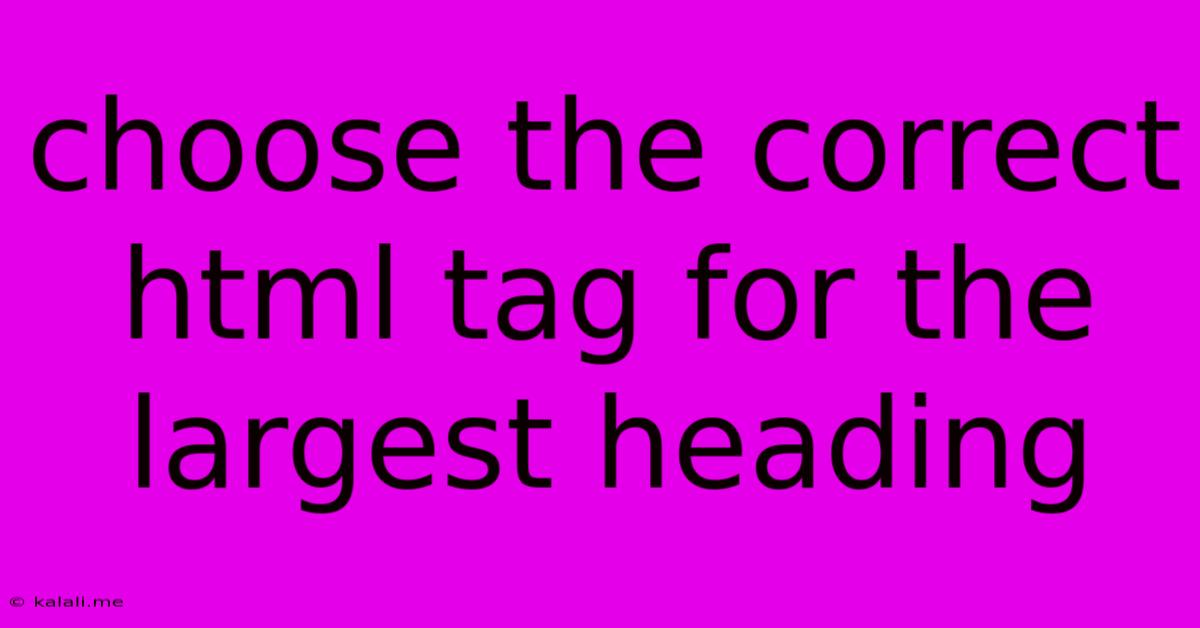Choose The Correct Html Tag For The Largest Heading
Kalali
Jun 13, 2025 · 3 min read

Table of Contents
Choose the Correct HTML Tag for the Largest Heading: A Definitive Guide
Choosing the right HTML heading tag is crucial for both website accessibility and search engine optimization (SEO). This guide will clarify which tag is the largest and explain why proper heading structure matters. Understanding this will improve your website's user experience and search engine rankings.
What is the largest heading tag? The answer is simple: <h1>. This tag designates the main heading of a page, and it's visually the largest heading by default in most browsers. Using it correctly is essential for creating well-structured and semantically meaningful HTML.
Why Use Heading Tags?
Heading tags (<h1> to <h6>) aren't just about making text bigger; they serve important purposes:
- Structure: They create a logical hierarchy for your content, making it easier for both users and search engines to understand the organization of your page.
- Accessibility: Screen readers and other assistive technologies rely on headings to navigate and understand web pages. Proper heading usage is crucial for accessibility.
- SEO: Search engines use headings to understand the content of your page and its importance. Using headings correctly can significantly improve your search rankings.
- Readability: Well-structured headings improve readability, helping users quickly scan and grasp the main points of your content.
The Hierarchy of Heading Tags
The heading tags follow a hierarchical structure:
<h1>: Main heading – Use only one<h1>per page. This represents the most important topic on the page.<h2>: Subheading – Used for sections within the main topic.<h3>: Sub-subheading – Further breaks down sections within<h2>.<h4>,<h5>,<h6>: Used for progressively smaller sections within the page's structure.
Common Mistakes to Avoid
- Skipping
<h1>: Never skip the<h1>tag. Always include one per page to denote the main topic. - Using multiple
<h1>tags: Only use one<h1>tag per page. Multiple<h1>tags confuse both users and search engines, diminishing your SEO efforts. - Incorrect nesting: Make sure your headings are nested correctly. A
<h3>should always be within a<h2>, and so on. Incorrect nesting leads to structural inconsistencies. - Ignoring semantic meaning: Don't use headings solely for styling. Always choose the heading level based on its hierarchical importance within the page's content.
Best Practices for Using Heading Tags
- Plan your headings: Before you start writing, outline your content and determine the appropriate heading levels.
- Use descriptive heading text: Make your headings clear, concise, and accurately reflect the content of the section.
- Keep it consistent: Maintain a logical and consistent heading structure throughout your website.
- Use heading tags sparingly: Don't overuse headings; use them strategically to organize your content effectively.
- Use CSS for styling: Use CSS to style your headings, rather than relying on the default browser styling. This allows you to maintain semantic accuracy while controlling visual presentation.
By correctly using the <h1> tag and following the proper hierarchy of heading tags, you'll create a more accessible, user-friendly, and SEO-optimized website. Remember, the <h1> is your primary heading, the cornerstone of your page's structure and organization. Use it wisely!
Latest Posts
Latest Posts
-
What Is Difference Between Pound And Kg
Jun 14, 2025
-
Which Phase Of Mitosis Is The Longest
Jun 14, 2025
-
Which Hormone Is Not Produced By The Placenta
Jun 14, 2025
-
The Electrons Present In The Outermost Shell Are Called
Jun 14, 2025
-
A Bar Magnet Is Placed In A Uniform Magnetic Field
Jun 14, 2025
Related Post
Thank you for visiting our website which covers about Choose The Correct Html Tag For The Largest Heading . We hope the information provided has been useful to you. Feel free to contact us if you have any questions or need further assistance. See you next time and don't miss to bookmark.